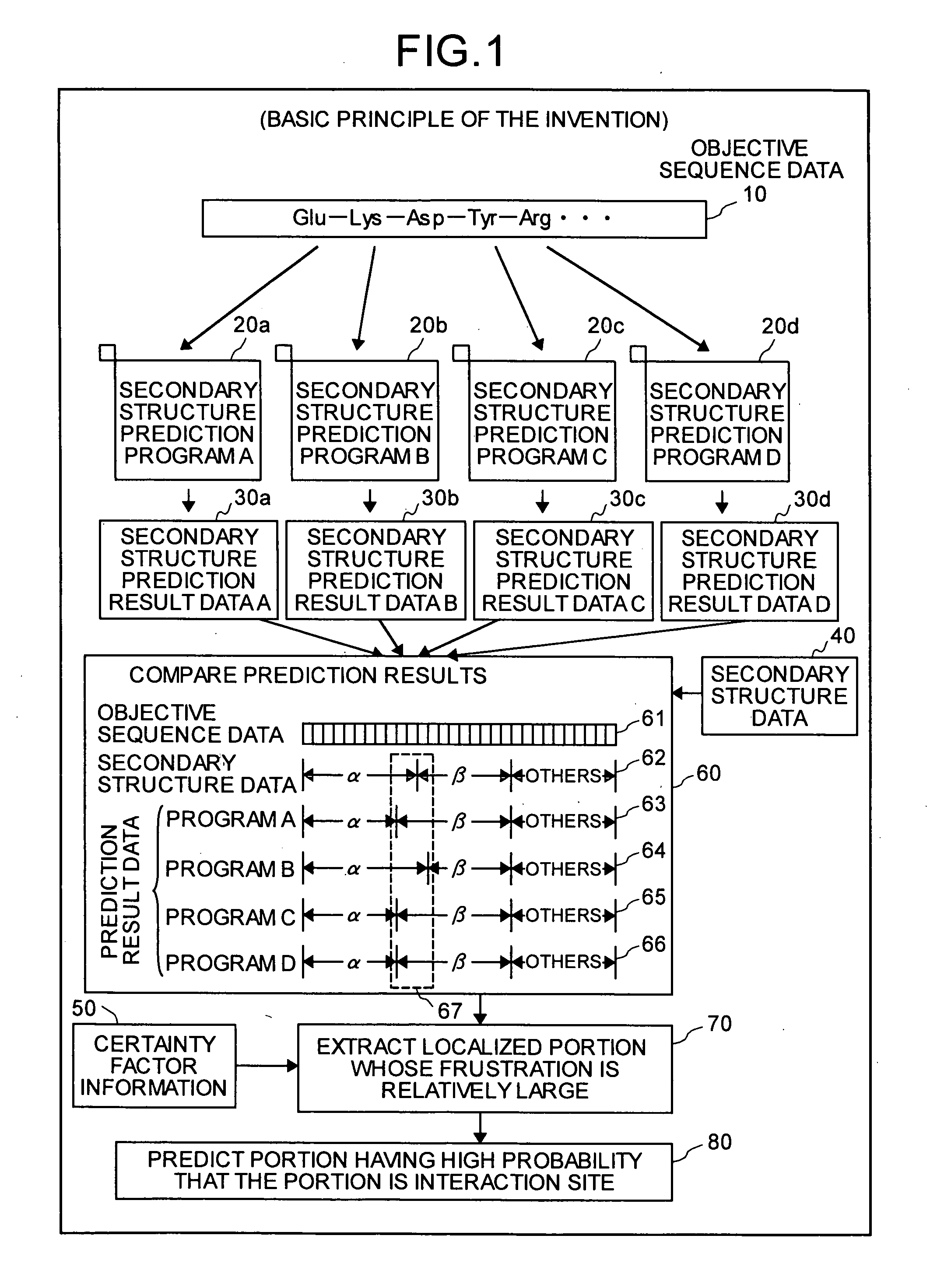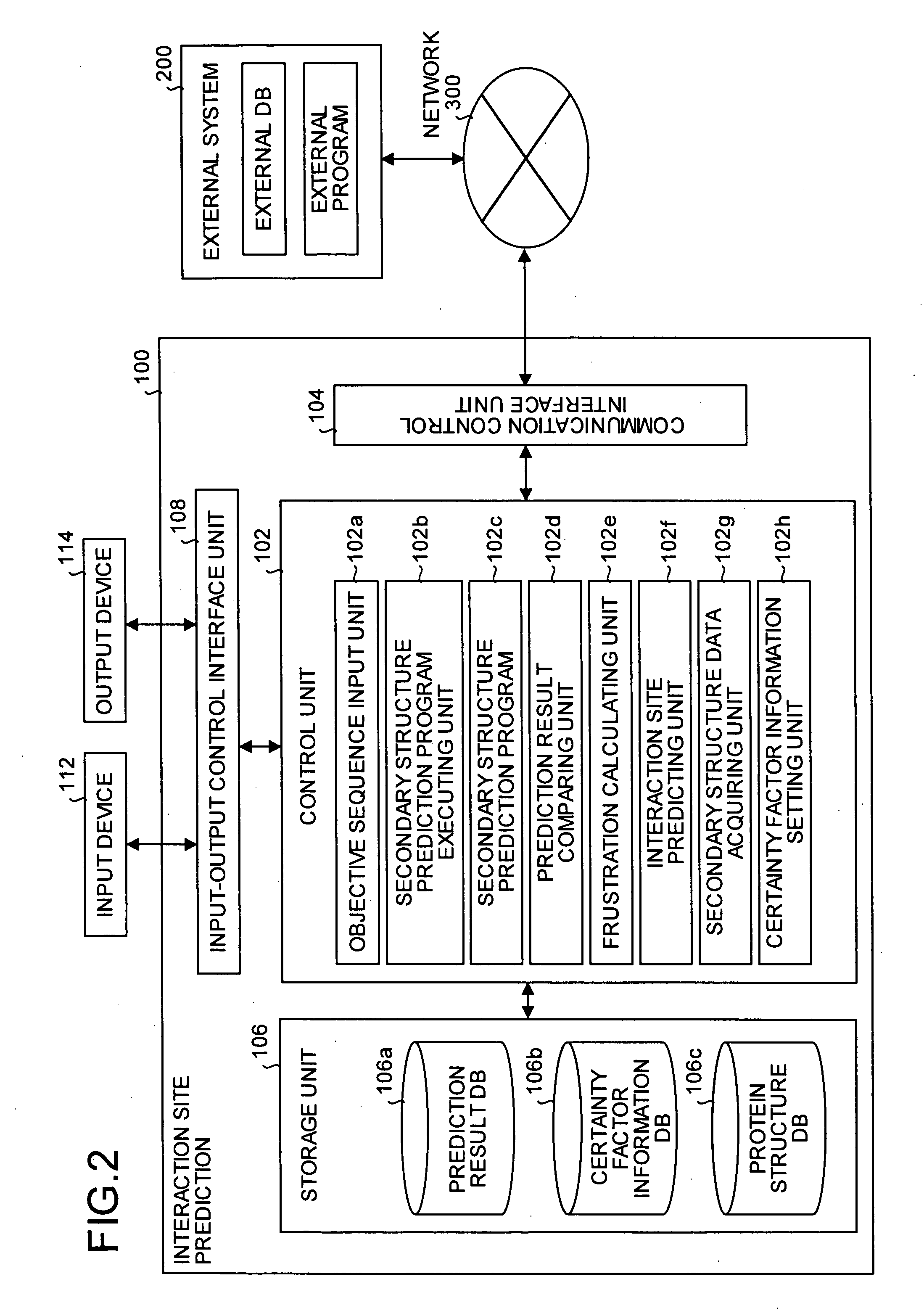Interaction predicting device
a prediction device and interaction site technology, applied in the field of interaction site prediction devices, interaction site prediction methods, programs and recording media, can solve the problems of inability to analyze unknown interaction sites, inability to analyze interaction sites that have not been found, and no effective approaches established, so as to speed up the optimization process
- Summary
- Abstract
- Description
- Claims
- Application Information
AI Technical Summary
Benefits of technology
Problems solved by technology
Method used
Image
Examples
embodiments
[0243] Referring to FIGS. 8 and 9, the following description will discuss embodiments of the present invention in detail.
[0244] The present embodiment exemplifies a case in which, with respect to amino acid sequences of Mammalian Adenylyl Cyclase (PDB ID: 1CJK)(referred to as “MAC” in the present specification), secondary structure predicting processes are carried out by using programs 1 and 2, and frustration values are calculated based upon the secondary structure prediction results so that interaction sites are predicted.
[0245]FIG. 8 is a drawing that depicts one example of a process-results output screen of the present embodiment displayed on the monitor of the interaction site predicting device 100. As shown in this Figure, the process-results output screen includes, for example, a display area MB-1 for a graph indicating the certainty factor when the amino acid sequence of MAC has a β-strand structure, a display area MB-2 for a graph indicating the certainty factor when the ...
first example
[0419] Referring to FIGS. 39 to 44, the following description will discuss the first example in detail. The first example explains a case in which “barnase” and “barstar” are used as proteins and the interaction site is specified.
[0420]FIG. 39 depicts a processing diagram in which the protein interaction information processing device 100 calculates a difference ΔS in the solvent contact areas for each of amino acid residues with respect to the barnase based upon the crystal structure of a barnase-barstar composite body through processes of the solvent contact face specifying unit 102b. As shown in this Figure, in the primary structure of the barnase, the difference ΔS in each of the 38th, 59th, 83rd and 102nd amino acid residues is large so that it is specified that the barnase interacts with the barstar in these sites.
[0421] Further, FIG. 40 depicts a processing diagram in which the protein interaction information processing device 100 calculates the hydrophobic interaction energ...
second example
[0427] Referring to FIGS. 45 to 50, the following description will discuss the second example in detail. The second example explains a case in which Ribonuclease and its Inhibitor are used as proteins and the interaction site is specified.
[0428]FIG. 45 depicts a processing diagram in which the protein interaction information processing device 100 calculates a difference ΔS in the solvent contact areas for each of amino acid residues with respect to the Ribonuclease based upon the crystal structure of a Ribonuclease-inhibitor composite body through processes of the solvent contact face specifying unit 102b. As shown in this Figure, in the primary structure of the Ribonuclease, the difference ΔS in the 39th amino acid residue is large so that it is specified that the Ribonuclease interacts with the inhibitor in this site.
[0429] Further, FIG. 46 depicts a processing diagram in which the protein interaction information processing device 100 calculates the hydrophobic interaction energ...
PUM
| Property | Measurement | Unit |
|---|---|---|
| energy gap | aaaaa | aaaaa |
| orbital energy | aaaaa | aaaaa |
| distance | aaaaa | aaaaa |
Abstract
Description
Claims
Application Information
 Login to View More
Login to View More - R&D
- Intellectual Property
- Life Sciences
- Materials
- Tech Scout
- Unparalleled Data Quality
- Higher Quality Content
- 60% Fewer Hallucinations
Browse by: Latest US Patents, China's latest patents, Technical Efficacy Thesaurus, Application Domain, Technology Topic, Popular Technical Reports.
© 2025 PatSnap. All rights reserved.Legal|Privacy policy|Modern Slavery Act Transparency Statement|Sitemap|About US| Contact US: help@patsnap.com



